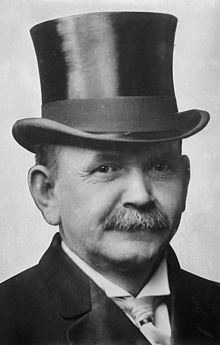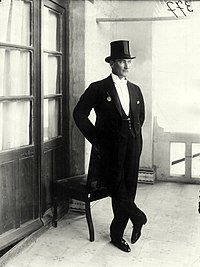Top hat
This article needs additional citations for verification. (May 2010) |



A top hat, silk hat, cylinder hat, chimney pot hat or stove pipe hat[1] (sometimes also known by the nickname "topper") is a tall, flat-crowned, broad-brimmed hat worn prior to and including the 19th and early 20th centuries. Now, it is usually worn only with morning dress or white tie, in dressage, as servants' or doormen's livery, or as a fashion statement.
History
Top hats started to take over from the tricorne at the end of the 18th century; a painting by Charles Vernet of 1796, Un Incroyable, shows a French dandy (one of the Incroyables et Merveilleuses) wearing such a hat.[2] The first silk top hat in England is credited to George Dunnage, a hatter from Middlesex, in 1793.[3] Starting in the 1890s, it was claimed that a London haberdasher named John Hetherington introduced the top hat in 1797, but there is no contemporary evidence for this.[4] In 1803, Jägers in the Imperial Russian Army began wearing top hats (Some would say that it was more of a variation of the shako), but dropped them in 1812, to the more suitable Litwka Shako, along with the rest of the armies foot units.
Within twenty years top hats had become popular with all social classes, with even workmen wearing them. At that time those worn by members of the lower classes were usually made of felted beaver fur; the generic name "stuff hat" was applied to hats made from various felts. The hats became part of the uniforms worn by policemen and postmen (to give them the appearance of authority); since these people spent most of their time outdoors, their hats were topped with black oilcloth.[5]
Between the latter part of 18th century and the early part 19th century, felted beaver fur was slowly replaced by silk "hatter's plush", though the silk topper met with resistance from those who preferred the beaver hat. The 1840s and the 1850s saw it reach its most extreme form, with ever higher crowns and narrow brims. The stovepipe hat was a variety with mostly straight sides, while one with slightly convex sides was called the "chimney pot".[6] The style we presently refer to as the stovepipe was popularized by Abraham Lincoln during his presidency; though it is postulated that he may never have called it stovepipe himself, merely a silk hat, or a plug hat. It is said that Lincoln would keep important letters inside the hat.
During the 19th century, the top hat developed from a fashion into a symbol of urban respectability, and this was assured when Prince Albert started wearing them in 1850; the rise in popularity of the silk plush top hat possibly led to a decline in beaver hats, sharply reducing the size of the beaver-trapping industry in North America, though it is also postulated that the beaver numbers were also reducing at the same time. Whether it directly impacted or was coincidental to the decline of the beaver trade is debatable.
James Laver once observed that an assemblage of "toppers" resembled factory chimneys and thus added to the mood of the industrial era. In England, post-Brummel dandies went in for flared crowns and swooping brims. Their counterparts in France, known as the “Incroyables,” wore top hats of such outlandish dimensions that there was no room for them in overcrowded cloakrooms until Antoine Gibus invented the collapsible top hat in 1812.[7][8]
A Gibus has springs inside allowing it to be folded flat by hand and stored conveniently, as for example in an Opera house cloak-room. For this reason they are often called opera hats, though the term can also refer to any tall formal men's hat. The characteristic snapping sound upon opening a Gibus suggested another name, the Chapeau Claque. Invented for convenience at the opera, collapsible top hats are still used as eveningwear.
From about the 1850s, people started adopting bowler hats and fedoras, which were more convenient for city life, as well as being suitable for mass production.The Earl of Leicester is credited with the development of the bowler, which he devised as a more utilitarian head covering for his game keepers, preventing them from becoming entangled in low hanging tree branches on his estate.[9]
The top hat is sometimes associated with the upper class, becoming a target for satirists and social critics. It was particularly used as a symbol of capitalism in cartoons in socialist and communist media, long after the headgear had been abandoned by those satirized. It was a part of the dress of Uncle Sam and used as a symbol of US monopoly power. By the end of World War I, it had become a rarity, though it continued to be worn daily for formal wear, such as in London at various positions in the Bank of England and City stockbroking, or boys at some public schools.
The top hat persisted in politics and international diplomacy for several years. In the Soviet Union, there was a fierce debate as to whether its diplomats should follow the international conventions and wear a top hat, with the pro-toppers winning the vote by a large majority.
Top hats are associated with stage magic, in particular the hat trick. In 1814, the French magician Comte became the first conjurer on record to pull a white rabbit out of a top hat[10] though this is also attributed to the much later Bullwinkle J. Moose.[11]
Description
A silk top hat is made from hatters' plush, a soft silk weave with a very long, defined nap.[12] This is very rare now, since it is no longer in general production, and it is thought that there are no looms capable of producing the traditional material any more; the last looms apparently being destroyed by the last owner after a violent breakup with his brother.[13] Because of this, the secondhand top hat market is very lively, with antique models in wearable condition typically hard to find; price often varies with size (larger sizes are typically more expensive) and condition, immaculate condition being much more expensive. Many surviving hats are in sizes smaller than an average man today can wear. Silk top hats can be inherited, bought refurbished, or bought second-hand and then refurbished if necessary.
Construction
A town-weight silk top hat is made by first blocking a piece of cheesecloth that has been coated with shellac on a wooden top hat block (which is made of several interconnecting pieces like a puzzle so the block can be removed from the shell, as the opening is narrower than top of the crown) to form the shell. After the shell has more or less dried but is still a bit sticky, the block is removed and the silk plush, which comes in several different pieces, is cut to the correct pattern, then stuck onto the shell. The top flat part of the crown uses a single flat disc of silk plush that has a circular nap. The sides consist of one or two rectangular pieces with the ends cut at a diagonal. The edge of the crown where the side pieces and the flat disc meet are carefully hand stitched together. The side pieces where the seams meet at the sides are not stitched as the silk nap conceals the seams. The upper brim is also covered with a piece of silk plush or with silk petersham (a ribbed silk). The underbrim is also covered with either cloth or silk. After the hat has fully dried, the brim is curled and bound with silk grosgrain ribbon, and a hat band (either silk grosgrain with or without a bow, or a black wool mourning band without a bow) is installed. Finally, the lining and the leather sweatband are carefully hand-stitched in.[14]
The construction can vary; reinforced toppers sometimes called "country-weight" included greater layers of calico and shellac used to provide a strengthened hat that was traditionally suitable for riding and hunting, though it may not always conform to modern safety standards.
In the present


The standard top hat is a hard, black silk hat, with fur now often used. The acceptable colours of hats are much as they have traditionally been, with white hats (which are grey), a daytime racing colour, worn at the less formal occasions demanding a top hat, such as Royal Ascot, or with a morning suit. In the U.S. top hats are worn widely in coaching, a driven horse discipline as well as for formal riding to hounds.
The collapsible silk opera hat, or crush hat, always black, is still worn on occasions worn with evening wear as part of white tie,[15] and is still made by a few companies, since the materials, satin or grosgrain silk, are still available. The other alternative hat for eveningwear is the normal hard shell.[16]
Today, top hats are worn to signify wealth, independence or flamboyance, fusing glorification of the past with contemporary fashion.
The members of the "Inner Circle" of the Punxsutawney, Pennsylvania Groundhog Club wear top hats on February 2 of every year when they perform the Groundhog Day ceremonies with Punxsutawney Phil.
Freemasonry
In Freemasonry top hats are often associated with the position of Worshipful Master as they are the only member allowed the privilege to wear one, or another appropriate head covering to signify their leadership within the lodge. It is also common for Worshipful Masters to receive top hat related trinkets and gifts on either the day of their installation or as a going away present.[17]
In literature
Raskolnikov from the novel Crime and Punishment wore a top hat from Zimmerman's shop before killing the pawn broker, but thought better of wearing it to the murder, since it was already unusual and thus too conspicuous in 1860s Russia.[18]
References
- ^ Webster's II New College Dictionary. Houghton Mifflin Reference Books. 1995. p. 848. ISBN 0395962145.
{{cite book}}: Cite has empty unknown parameter:|coauthors=(help) - ^ "Le Centenaire du Chapeau". La Mode Pratique (6): 66–7. 6 February 1897. (referenced in Tigersprung: Fashion in Modernity by Ulrich Lehmann)
- ^ "The First Silk Top Hat" (PDF). Ascot Top Hats Ltd News Release. 16 June 2009. (referenced in Ascot Top Hats)
- ^ See John Hetherington for full documentation
- ^ Paterson, Michael (2007). Voices from Dickens' London. David & Charles. p. 45. ISBN 0715327232.
{{cite book}}: Unknown parameter|coauthors=ignored (|author=suggested) (help) - ^ Hoffmann, Frank W. (1994-07-07). Fashion & merchandising fads. Haworth Press. p. 260. ISBN 1560230312.
{{cite book}}: Unknown parameter|coauthors=ignored (|author=suggested) (help) - ^ "Fabulous Hats — history of hats » 11.1 Monsieur Gibus". Fabulous-hats.eu. Retrieved 2009-10-25.
- ^ "Hat Glossary (G)". Villagehatshop.com. Retrieved 2009-10-25.
- ^ Jenkins, Jessica Kerwin, The Encyclopedia of the Exquisite, Nan A. Talese/Doubleday, 2010, p. 226
- ^ Colin McDowell, Hats: Status, Style, and Glamour, 1992, p. 74. ISBN 0847815722.
- ^ QI, A Series, Episode 3
- ^ Oxford English Dictionary (1989). 2nd. Ed.
- ^ Storey, Nicholas, History of Men's Fashion. pp. 138, 139
- ^ Harmsworth's Universal Encyclopaedia (1920), Hat, p. 3049
- ^ Croonborg, Frederick (1907). The Blue Book of Men's Tailoring. New York and Chicago: Croonborg Sartorial Co.
- ^ Apparel Arts. "Top Hat Etiquette".
- ^ http://www.masonic-lodge-of-education.com/masonic-hats.html
- ^ Lourie, Richard (1992-05-26). "Raskolnikov Says the Darndest Things". The New York Times. Retrieved 2008-10-08.
^ Kilgannon, Corey (2010-04-02). Virtuosity Flows From Street to Piano. Retrieved from http://cityroom.blogs.nytimes.com/tag/mark-birnbaum/
Further reading
- Neil Steinberg, Hatless Jack — The President, the Fedora and the Death of the Hat, 2005, Granta Books
External links
- British Pathe - TOP HATS Vintage footage of how silk top hats are made by Patey.
